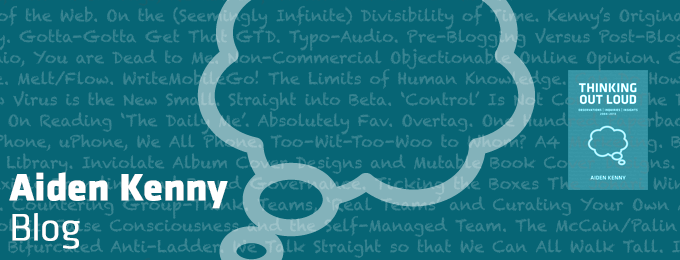This year I have decided to just post about only one of the presentations I attended at the Offset 2013 conference. This is due to a combination of my taking far fewer notes than in previous years and many of the best talks this year not lending themselves to concise summaries. Iain Tait, the Executive Creative Director at Google’s Creative Labs, spoke on the first day and gave the most impressive presentation of the three-day event. (Bob Gill was arguably the most challenging and entertaining speaker, but on reflection Tait was more relevant, informative, and proposed superior useful actionable ideas.) Two aspects of Tait’s presentation are worth remarking on.
Firstly, he discussed an increasingly critical axis of conflict within online agencies between the ‘Attention Engineers’ and the ‘Experience Engineers’. These different mindsets are almost diametrically opposed. Within the social mediascape people trend towards operating in a mode which Tait christened ‘Hyperactive Squirrel Time’. So there is a constant increasing pressure for the newest, newest, newest news. Agencies are now hyper-aware of how they can feed into that incessant demand. ‘Attention Engineers’ is his phrase for those concerned with chasing eyeballs above all and using whatever mechanisms and strategies they can devise to achieve that end. Tait explained how Attention Engineers today are often creating advertising campaigns specifically constructed as bait for news stories. The actual communicative intent of those campaigns is only secondary, as their real value lies in the related media coverage that they generate.
In contrast, Tait espoused the approach which he characterised as ”Experience Engineering”. This prioritises crafting immersive, consistent digital experiences. He spoke about true end-to-end design where every interaction supports the overall intent of the digital campaign or service. His observations resonated with me. My own background in branding has always been more focused on constructing the systematic design language of brand identity, by addressing the holistic and immersive visual grammar that unites the disparate facets of all of an organisation’s expressions, and building everything upon an underlying consistency of details. My OCD/ADD cartoon from 2006 expresses my preference to think in the mode of an Experience Engineer.
Secondly, the spine of his presentation was his ‘Principles of Hackery’. This was about reminding all of the designers about the true, positive, sense of the word ‘Hack’, (as it is used in Hackathons and Life Hacks and suchlike) and encouraging them to integrate it into their personal creative strategies. While the hacker ethos is a core cultural attribute underpinning the ongoing success of global technology giants such as Google and Facebook, it still has much untapped potential within the broader design sector. Just as Business (with a capital B) has recently rediscovered that it can learn many valuable insights from design thinking, so too can Design (also capitalised) equally learn from applying some hacker thinking.
Tait cited seven useful principles and illustrated each of them with some surprising examples and illuminating case studies.
- Work with what you have – not what you wish you have. (Also: do as much as you can with as little as you can.)
- Fixing things is cool. (See ‘The Fixers Manifesto’ by Sugru.)
- Letting others use your voice is awesome. (Also: encouraging other people to fix your own stuff is cool too.)
- Beautiful hacks can be super-ugly.
- Hacks can be beautiful and charming too.
- Keep everything in flux as long as possible. (As you just never know what is coming down the line.)
- Be respectful of the Network.


No comments:
Post a Comment